Abstract
An examination of the Molecular, chemical and physical properties of drugs is very critical in determining the effect on biopharmaceutical features. Electrochemical and stereochemical properties are particularly essential in determining route of administration, absorption, distribution, metabolism and elimination of drugs.
Introduction
Diabetes mellitus refers to a condition where the human body is unable to regulate its blood sugar levels. The inability to regulate blood sugar may be due to insulin deficiciency or insulin insensitivity. The basic treatment for diabetes is the administration of anti-diabetic agents, whose overall effect is hypoglycemia. Anti diabetic agents include compounds which stimulate insulin secretion by pancreatic islets, compounds which increase sensitivity to insulin in organs or compounds which alter the glucose absorption. Some compounds are used in monotherapies while others are combined with other agents. The first compounds to be used in management of blood sugar are Sulfonylureas. These products were widely used to stimulate insulin production and release in the pancreas. Examples of these sulfonylurea are Tolbutamide also known as Orinase and glipizide commonly known as glucotrol. They bind strongly to plasma proteins. Meglitinides are the other class of anti diabetics whose mode of action is by opening the calcium channels and closing the potassium channel which increases the rate of insulin production in the beta cells in the pancreas. Examples of meglitinides are Repaglinide also known as Prandin and Nateglinide commonly known as Starlix. Biguanides are the commonly used medications in controlling type 2 diabetes mellitus. They increase the metabolism of glucose in skeletal muscle and peripheral organs. Typical biguanides commonly used include Metformin traded as glucophage. Thiazolidinediones also known as glitazones work by activating regulatory proteins. An example of a glitazone compound is rosiglitazone and Pioglitazone. This project will keenly discuss classification, therapeutic use, molecular properties and their effects on biopharmaceutical features of six common anti diabetic agents.
Metformin
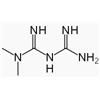
Classification, therapeutic use and pharmacology
The agent Metformin was first described in scientific documentation in 1922. Metformin was approved by the food and drug administration for treatment of type 2 diabetes mellitus in 1994. The active ingredient is Metformin that exhibits hypoglycemic tendencies. This is the drug of choice for type 2 diabetes mellitus. It is strongly indicated for diabetic patients who present with overweight and obesity (Adams, 2003). The drug is also gaining wide use in other conditions associated with insulin dysfunctions. Metformin is contraindicated to patients with kidney diseases, ketonuria, and a history of lactic acidosis, lung disease and liver function disorders (Walsh, 2008).
Molecular, physical and chemical properties; similarities and differences
Metformin has a molecular weight of 129.164 g/mol and its molecular formula is C4H11N5. It has 5 hydrogen bond acceptors, 3 hydrogen bond donors and zero formal charge. It is a white powder which is odorless and no flavor. The Metformin chloride agent is highly soluble in water. It has a hydrophobic triacetyl-beta-cyclodextrin.
Metformin hydrochloride also known as Glucophage has a pka of 12.4 and 1% aqueous solution of the drug has a pH value of 6.68. Metformin hydrochloride chemical and pharmacological properties are different from the other anti diabetic agents discussed in this project. The stereo chemical properties allow the molecule to crystallize with one dimethyle molecule in the monolithic arrangement.
Effects of molecular properties on biopharmaceutical features of the drug
Metformin is normally delivered by oral administration and its absorption is slow. It has an oral bioavailability of about 60% with peak plasma levels reached between one to four hours for immediate release Metformin. Due to its low plasma protein binding properties, the drugs biodegradation is poor. Metformin is distributed in red corpuscles and is finally eliminated from the body through urine (Jeremy, 2007).
Nateglinide
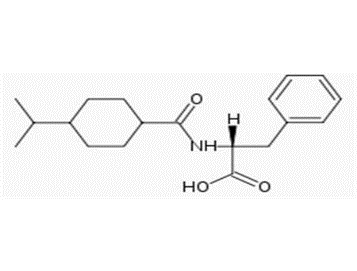
Classification, therapeutic use and pharmacology
Nateglinide was developed by Norvatis as an anti diabetic agent. It has been used extensively as a single therapy for type 2 diabetes. The drug lowers blood sugar by enhancing insulin production through an ATP depended mechanism. Nateglinide belongs to the group of meglitinides.
Molecular, physical and chemical properties; similarities and differences
Nateglinide is a white powder. It is insoluble in water but readily soluble in ethanol. It has a molecular weight of 317.43. Its molecular structure is (C19H27NO3) that is (R)-2-(4-isopropylcyclohexanecarboxamido)-3-phenylpropanoic acid. Colloidal silicon dioxide and lactose monohydrate form the basic inactive ingredients in the drug Nateglinide. The amino acid derivative has a pKa of 3.1 which is associated with its acidic carboxylic group. This explains the fast absorption of the drug.
Effects of molecular properties on biopharmaceutical features of the drug
Nateglinide has a plasma protein binding affinity of 98% and an half life of one and half hours.
Pioglitazone
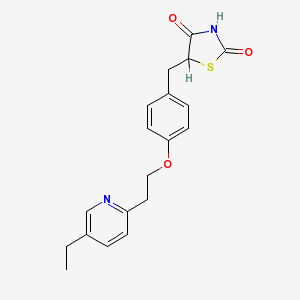
Classification, therapeutic use and pharmacology
Pioglitazone belongs to a group of drugs known as thiazolidinediones. The anti diabetic agent acts as an agonist at the PPAR in hepatic cells, skeletal muscles and fat tissues. Pioglitazone is a very useful drug used in the management of type 2 diabetes mellitus. Historically, the drug has been combined with insulin or Metformin although it can still be used alone. There are experimental studies going on to determine its effect on non alcoholic steatohepatitis. The drug helps to decrease insulin insensitivity in skeletal muscle, fat tissues and hepatic tissues. Pioglitazone is contraindicated in patients with a history of hypersensitivity as well as liver function disorders. The possible side effects include muscle pain, peripheral edema and osteomylitis (Lebovitz, 2004).
Molecular, physical and chemical properties; similarities and differences
Its molecular formula is C19H20N2O3S and a molecular weight of 356.44 g/mol. IUPAC name is 5-((4-2-(5-ethylpyridin-2yl) ethoxy)phenyl)methyl)-1, 3-thiazolidine-2, 4-dione.It is covalently bonded with 4 hydrogen bond acceptors and 1 hydrogen bond donor. Pioglitazone has two pKa levels, 5.8 and 6.4.
The effect of molecular properties on biopharmaceutical features of the drug
Pioglitazone has a very high plasma protein binding capacity of 99%. The peak plasma concentration is reached at 2 hours after administration with a half life of between 4-6 hours. The drug is mainly metabolized by hepatic degradation and excreted through urine and faeces.
Tolbutamide

Classification, therapeutic use and pharmacology
In circumstances where dietary method alone is not able to control type 2 diabetes, Tolbutamide is applied. It stimulates the production and secretion of insulin in the pancreatic islets by blocking the potassium ion channel. The compound is strongly contraindicated to patients with allergic sensitivity to Tolbutamide and sulfonamide. There drug is associated with some severe side effects like hypoglycemia and weight gain.
The effect of molecular properties on biopharmaceutical features of the drug
Tolbutamide is administered orally. Once in the gastrointestinal tract, Tolbutamide is rapidly absorbed. Peak plasma concentrations are reached after 3-4 hours of oral administration of a 500 mg tablet. Tolbutamide has a half life of 5 hours. During metabolism, the drug Tolbutamide is degraded through the process of oxidation. Due to the lack of a P- amino group, the anti diabetic agent is not exposed to the process of acetylation. After biodegradation the drug is metabolized to inactive metabolites which are eliminated from the body via the urinary and faecal route. Orinase has a melting point of 128.5 degree Celsius and an experimental water solubility of 109 mg/l. The pka of Tolbutamide which defines the isoelectric point is 5.16.
Repaglinide
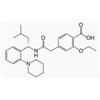
Classification, therapeutic use and pharmacology
This is another anti diabetic agent that belongs to the group of meglitinide. It lowers blood sugar by enhancing insulin production in the pancreatic islets. The drug is contraindicated for patients with hypersensitivity. Patients may experience mild hypoglycemia, sweating, headaches, nervousness or irritability (Ambavane et al, 2002).
The effect of molecular properties on biopharmaceutical features of the drug
Once in the body, the drug is rapidly absorbed and has a bioavailability of 60%. It reaches peak concentration values after one hour of an oral 2mg dosage. The compound is highly bound to plasma proteins. Metabolism occurs in the liver via the hepatic cytochrome enzymatic reactions. Inactive metabolites are finally eliminated through billiary and faecal route (Soumyanath, 2005). Repaglinide is a weakly acidic compound with two pKa value of 4.19 and 5.78.
Rosiglitazone
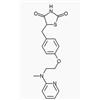
Classification, therapeutic use and pharmacology
Rosiglitazone is produced by the GlaxoSmithKline pharmaceutical company as an anti diabetic agent. It belongs to the group of thiaxolidenediones. It reduces insulin insensitivity and has anti inflammatory properties. The drug is contraindicated in patients with heart problems. The possible side effects of using rosiglitazone include frequent fractures and macular edema. However the side effects are not well documented and there is a lot of ongoing research work.
Molecular, physical and chemical properties; similarities and differences
The anti diabetic agent has a molecular weight of 357.427 g/mol. Its molecular formula is C18H19N3O3S. It is covalently bonded, with 5 hydrogen bond acceptors and 1 hydrogen bond donor. (Jelodar, 2007). Rosiglitazone maleate is a white solid compound with a melting point of 123 degree Celsius and pKa values of 6.1 and 6.8. The drug is pharmacologically and chemically different from the other oral hypoglycemic agents. As a result of its interconversion properties, its enantiomers are functionally similar. The molecule possesses one chiral centre.
The effect of molecular properties on biopharmaceutical features of the drug
The drug rosiglitazone has a very high protein binding affinity of 99%. It has a bioavailability of 99% and an half life of 4 hours. It is metabolized by hepatic cytochrome enzyme system and finally eliminated via renal and fecal routes.
Conclusion
It is clear that the anti diabetic agents discussed above have contributed immensely in the management of diabetes. However, extensive research should be done to eliminate the risk of severe side effects. It is imperative to note that with the current growth in diabetes cases, the use of insulin and oral hypoglycemic compounds will continue to increase. Prevention measures should also be employed to complement management efforts. Governments and private organizations should invest in creating awareness on diet and nutrition. In my observation, drug companies need to focus on research and development activities so as to come up with more efficient drugs and improve the quality of existing anti diabetics.
References
Adams, M. (2003). Core Concepts in Pharmacology. New York: CRC Press
Ambavane, V. Patil, R. and Ainapure, S. (2002). Repaglinide: a short acting insulin secretagogue for postprandial hyperglycemia.
Jelodar G, (2007). Effects OF Walnut leaf, coriander and pomegranate on blood glucose and histopathology of pancreas of alloxan induced diabetic rats. Web.
Jeremy, G. (2007). Prescribing by Numbers: Drugs and the Definition of Disease. Baltimore: Johns Hopkins University Press.
Leach, A. (2007). Structure-based Drug Discovery. Berlin: Springer.
Lebovitz, H. (2004). Therapy for Diabetes Mellitus and Related Disorders (4th Ed). Alexandria, American Diabetes Association.
McNeill, John H. (1999). Experimental Models of Diabetes. New York: CRC Press.
Philip, J. (1999). Synthetic Panics: The Symbolic Politics of Designer Drugs. New York: New York University Press.
Soumyanath, A. (2005). Traditional Medicines for Modern Times.Oxford: Oxford University Press.
Walsh, G. (2008). Biopharmaceuticals: Biochemistry and Biotechnology, Second Edition. John Wiley & Sons Ltd.